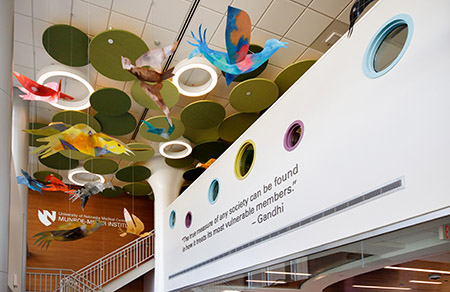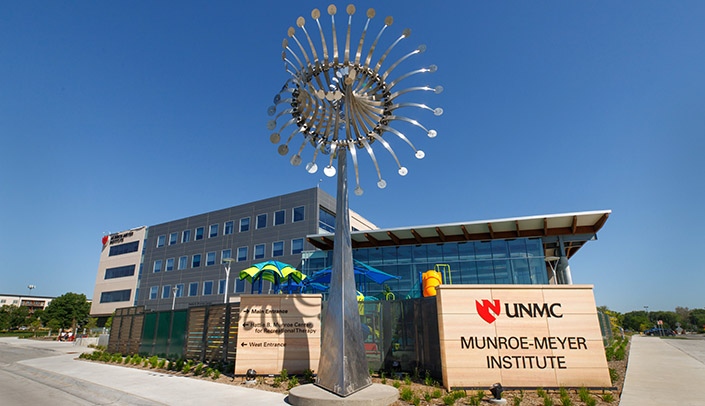When Heidi Sommer got her first glimpse of "Soar" – the large, kinetic metal sculpture by artist Anthony Howe that stands near the south entrance of the new Munroe-Meyer Institute – her first reaction was to smile with joy.
At first, she couldn't understand the sculpture, she said. "But then, when it begins to move. . . it’s quite beautiful."
She said the piece reminded her of how she sees her son’s disability.
"It’s a challenge, but there are a lot of beautiful things that come with it. He’s touched so many lives."
Sommer’s reaction — immediate, delighted, personal — is one of the effects MMI’s leaders hoped to have when they chose the messaging and artwork for the walls of the new building, located at 6902 Pine St. in Omaha — including "Soar," which was donated by the Don Scott family in honor of Ruth Scott.
Melonie Welsh, director of community engagement, had been speaking to the McGoogan Health Sciences Library's Emily McElroy and Linda Love, EdD, about being intentional with UNMC campus spaces. The library has just undergone renovations, including the opening of the Wigton Heritage Center.
 |
| Therman Statom's stylized birds make for a colorful welcome at the main MMI entrance, while a quote from Gandhi helps illustrate the institute's mission. |
"It’s not just about art," Dr. Love said. "It’s about how we make our plentiful number of walls work harder to express our values and attract people toward us, messaging out to anyone who comes through our hallways."
In MMI’s case, the message is one of belonging, inclusion and caring.
"Essentially, we wanted the building and our walls to help us convey our belief that anyone, regardless of their ability, color, gender or place of origin, could be successful at home, school and in the community," Welsh said. "That message is not only important for the families we serve, but our students and staff.
"With our public art and other pieces, our story is about this inclusiveness, soaring," Welsh said, pointing to the birds by artist Therman Statom that hang in the main entrance area, and the quote by Gandhi — "The true measure of any society can be found in how it treats its most vulnerable members" – that greets visitors as they enter the building.
Except for a commissioned piece by local artist Lisa Worrall, which was specific in showing diversity in age, diagnosis and race – and includes some stylized images of actual MMI clients — the building intentionally steered away from portrait shots. Though there are historical images and images of clients on the fourth floor, which is administrative space, the goal was to make room for colorful art intended to express diversity and a sense of welcome and caring.
"As much as we could, we wanted our artists to have some connection with disability or the disability community," Welsh said. "And as much as we could, we wanted that message of inclusion and welcome."
Textures, colors, subject matter and placement all was intentional. One colorful, three-dimensional piece on the building’s second floor proved so entrancing for young visitors, it had to be enclosed in a case so fascinated children wouldn’t unintentionally break it. Shadow boxes on display were created by participants in MMI’s recreational therapy and Trailblazer programs.
"Even the genres of the art — we have some contemporary pieces, some landscapes, some traditional work, because everyone is different and has different things they can relate to," Welsh said.
Sculptor Howe said that he has often received emails from parents of children with intellectual or developmental disabilities that say the children are drawn to videos of Howe’s work.
"Ever since I started making kinetic sculptures, one of my aspirations from the very beginning was that these would help people relax when they looked at them," he said.
Sommer said the sculptures, and MMI’s other messaging and artworks, have enhanced her experience there.
"I feel that whole building, and I’ve toured a lot of it, was built with an intention to serve this population with disabilities," Sommer said. "There wasn’t anything missed. And the art brings me a lot of joy — every time I go there, I smile. MMI is one of my favorite places, because my son is profoundly accepted there – it makes such a positive impact on my life."
And Sommer shared a message for Howe.
"Those two sculptures, when you see then, it’s not just beautiful, there’s not just a profound meaning behind them. But the children MMI serves really love them."
